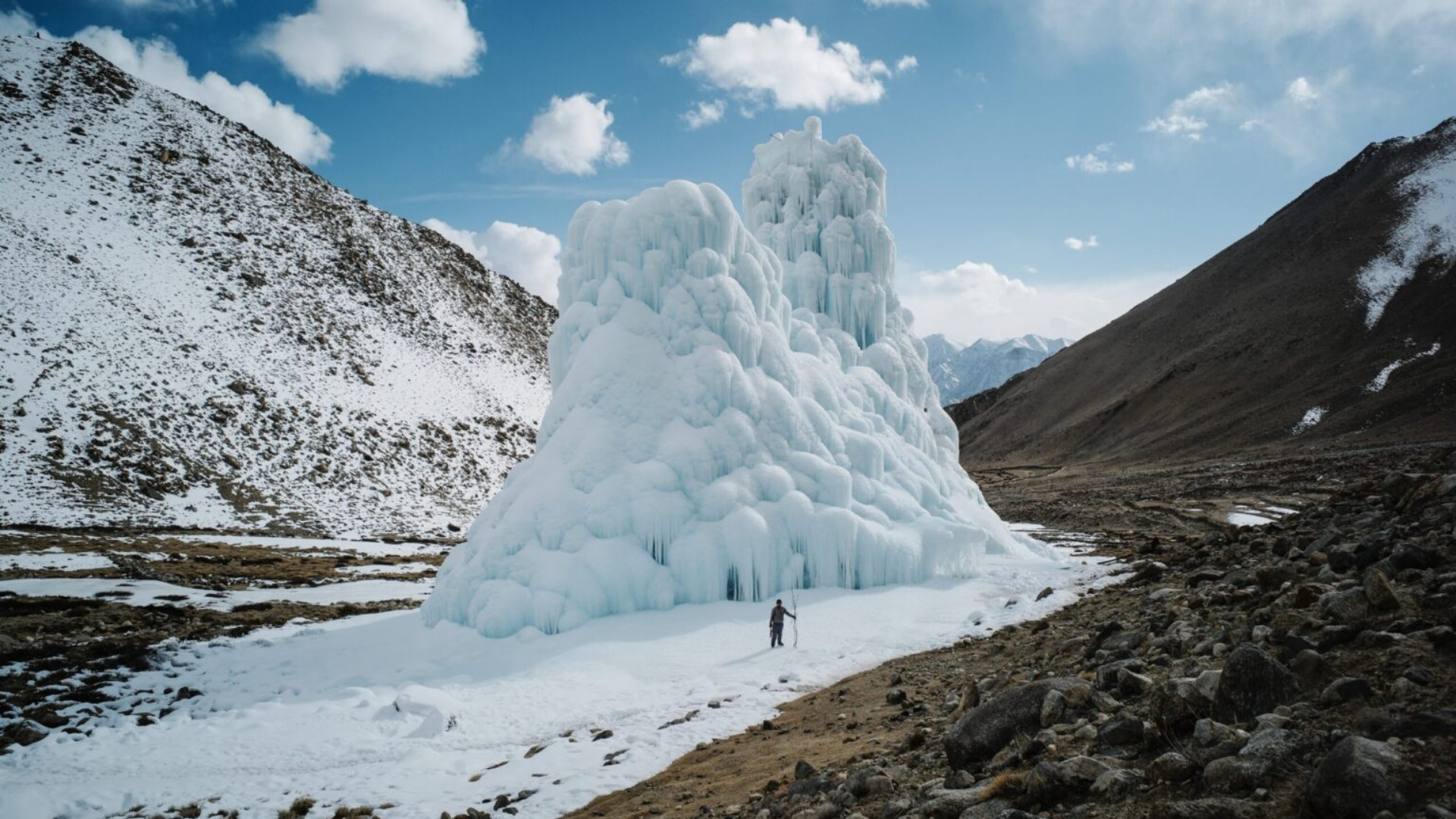HIMALAYAN ICE STUPA | GLACIER MELTING| HIGH ALTITUDE FARMING | WATER TROUBLES

As snowlines rise and mountain springs run dry, Nepal’s high-altitude communities are facing an increasingly urgent question: how to farm in a land where water arrives in the wrong season, or not at all.
A traditional farming rhythm once dictated by snowmelt and seasonal rainfall has been thrown off balance by climate change—and the impact is stark. Scientists and local groups are testing an idea called ice stupas—man-made ice towers that store winter water and release it in spring when farmers need it most.
Nepal’s latest agriculture census shows that only 23.2% farms in Nepal’s mountains have irrigation. Most rely on rain or natural springs, which have become unreliable.
Meanwhile, the area available for farming is shrinking. The census found cultivable land had dropped from 2.5 million hectares in 2011/12 to 2.2 million hectares in 2021/22, including a 7% drop in mountain districts—from 451,154 hectares to 419,252 over the decade. People are moving away from villages, partly because farming is becoming harder.
Melting glaciers and dry springs
A 2023 report from the International Centre for Integrated Mountain Development (ICIMOD) warns that by the year 2100, Nepal and the greater Hindu Kush Himalaya region could lose up to 75% of their glacier ice. This means less meltwater to feed rivers and springs in summer.
Springs that once provided water for homes and fields are drying up earlier each year. Water from glaciers now melts mostly in winter when farmers don’t need it, leaving little for the crucial spring planting season.
In May 2025, scientists and local communities held a “funeral” for the Yala Glacier in Nepal’s Langtang National Park. This glacier has lost more than 75% of its ice in recent decades. The ceremony was a way to raise awareness of the rapid glacier loss threatening water supplies for millions downstream.
What are ice stupas?
It’s a simple solution—freezing winter water for use during the dry season.
Large, cone-shaped ice towers are made by spraying winter water into cold air so it freezes into an ice heap. This water is stored as ice during the winter and melts slowly in spring, providing much-needed water for farming.
The idea was first developed in 2013 by engineer Sonam Wangchuk in Ladakh, India, and has since been used in many cold mountain areas.
Last winter, the Himalayan Institute of Alternatives, Ladakh (HIAL), led the creation of 34 ice stupas and artificial glaciers across six countries, conserving approximately 90 million litres of water.
In Ladakh alone, 23 Ice Stupas were built in 20 villages, storing around 68 million litres of water for future use. Pilot projects have been carried out in Nepal, Pakistan, Kyrgyzstan, Mongolia and Switzerland, among others. A typical ice stupa can be anything between 20 feet to 60 feet high.
The European Geosciences Union (EGU) in its 2017 Cryosphere blog post highlighted the growing use of ice stupas in the cold, arid parts of the Himalayas—particularly in Ladakh, India—as an innovative response to seasonal water shortages.
The blog described how these ‘artificial glaciers’ help mountain communities store and manage winter meltwater, enabling them to meet irrigation needs during the critical spring and early summer months when natural water sources often run dry.
Nepal’s first ice stupa
In 2022, the Videh Foundation built Nepal’s first ice stupa in Chhoser village, Upper Mustang, at an altitude of 4,100 meters.
“There are many barren lands in the surroundings of [Lo Manthang] (Upper Mustang) which [have] the possibilities of becoming green with the vegetation once these Ice Stupas are constructed and [utilised],” the foundation noted then. “The local government seemed very positive with this whole project and they are ready to invest their money in future Ice Stupas.”
The stupa helped save winter water that would have otherwise been lost and released it during the growing season. But the project also faced several challenges, such as low water pressure due to slope and terrain, durability of pipes which were damaged by wind and freezing temperatures, limited irrigation channels, and that residents needed more training to maintain the system.
What ice stupas can and cannot do
Ice stupas can store winter water without electricity, provide a steady supply in spring for crops, be built cheaply in freezing mountain areas, and help local communities adapt to water shortages, among others.
However, they have limitations: they require colder winters to form ice, a reliable water source located above the village, and trained individuals for setup and maintenance.
While mountain water scarcity is a significant climate-related problem, ice stupas represent a promising example of the water-saving technologies and seasonal water storage solutions envisaged in the country’s National Adaptation Plan (NAP) 2021-2050. They are not a cure-all, but in the right places, these ice towers can aid water and farming.
Read More Stories
Kathmandu’s decay: From glorious past to ominous future
Kathmandu: The legend and the legacy Legend about Kathmandus evolution holds that the...
Kathmandu - A crumbling valley!
Valleys and cities should be young, vibrant, inspiring and full of hopes with...
Understanding federal grants in fiscal federalism
Local budgets are where democracy meets the daily lives of citizensthis is a...